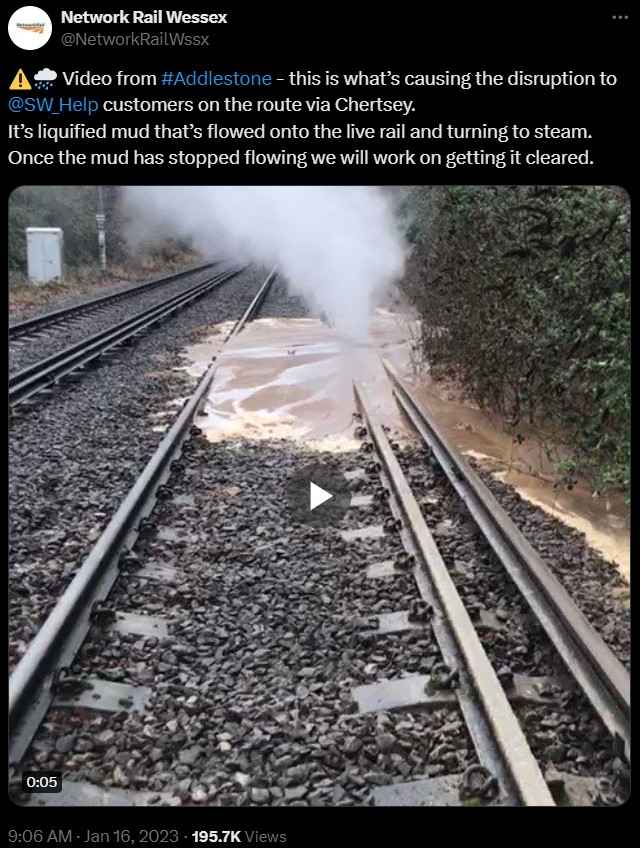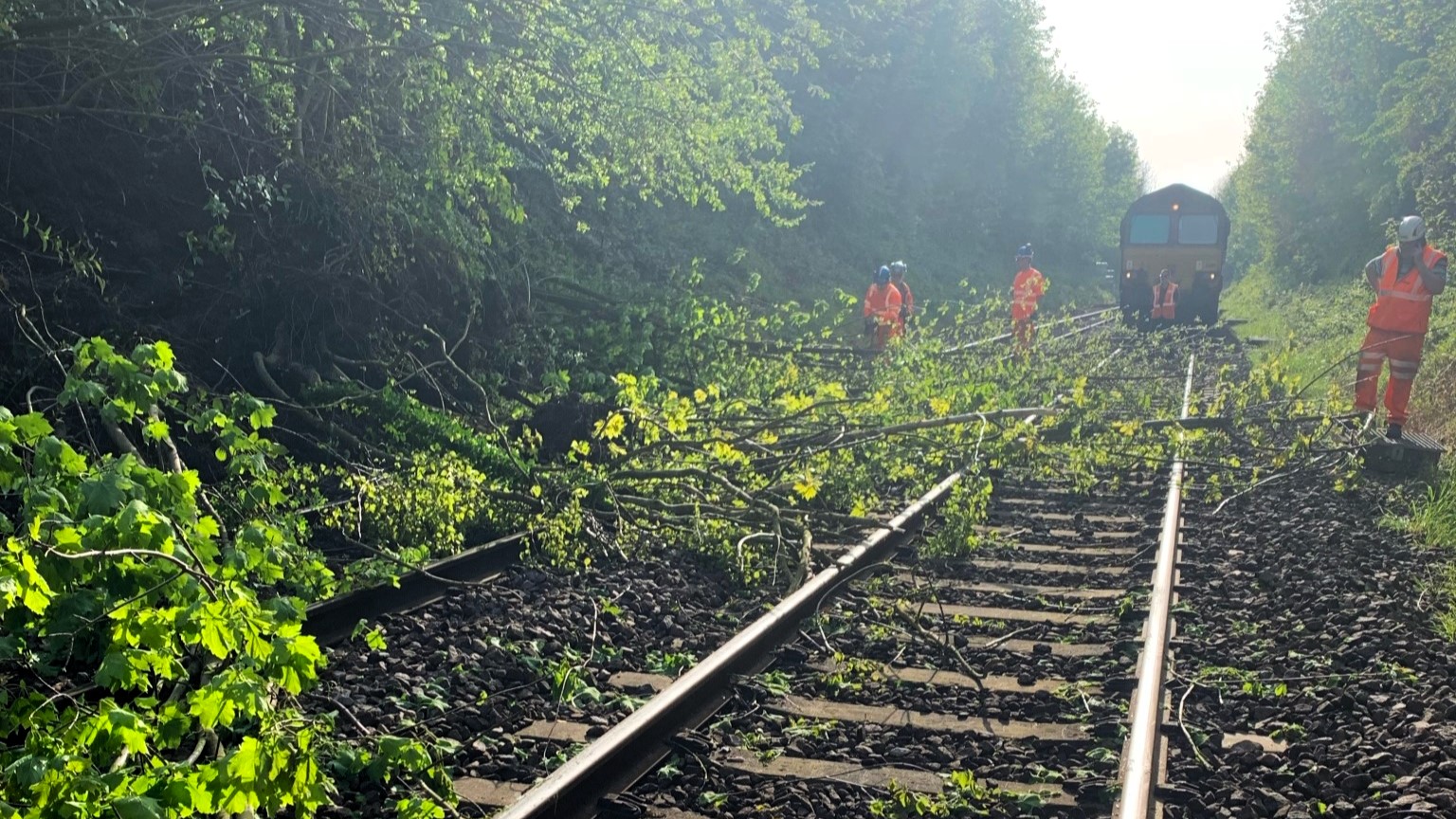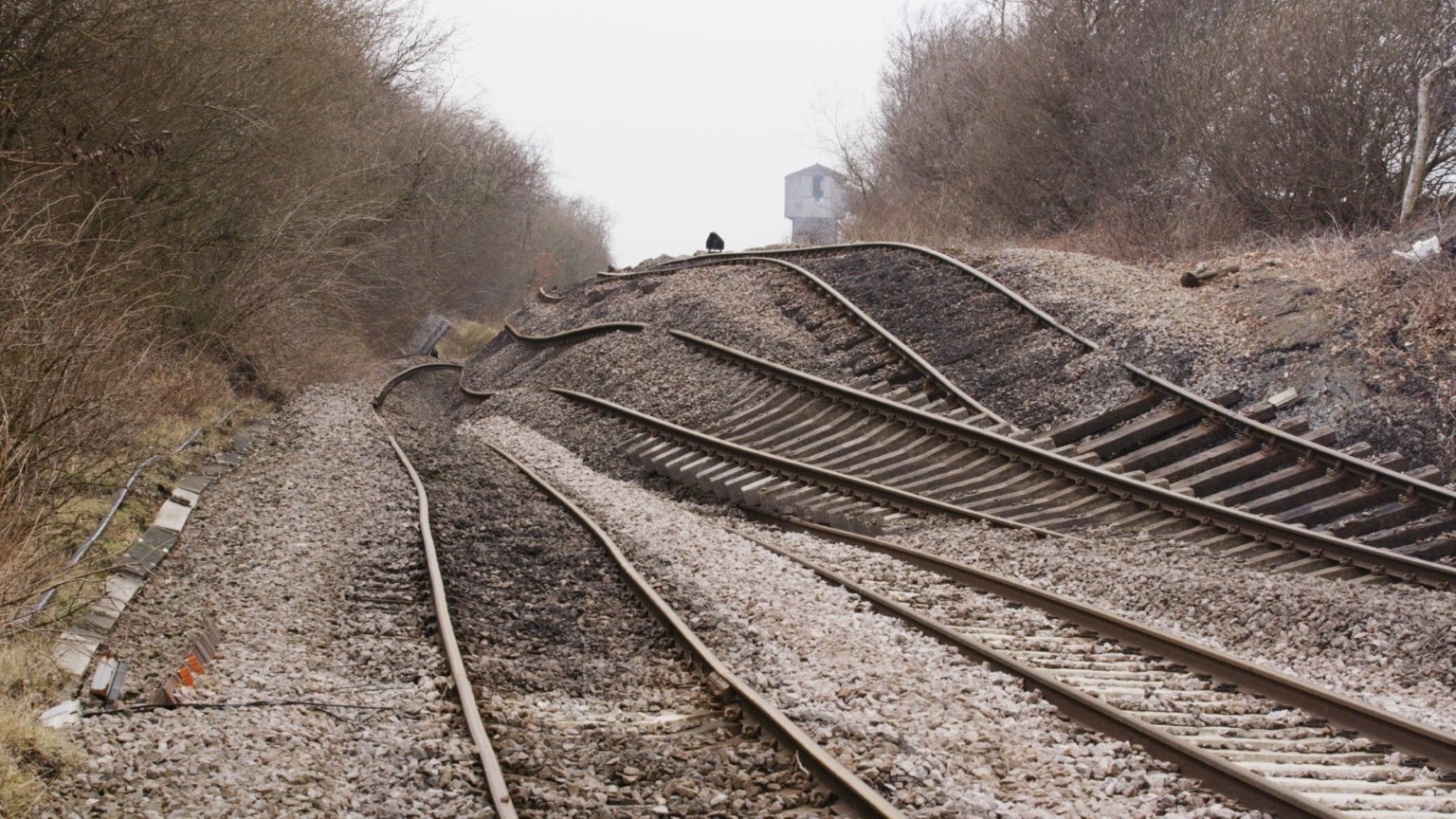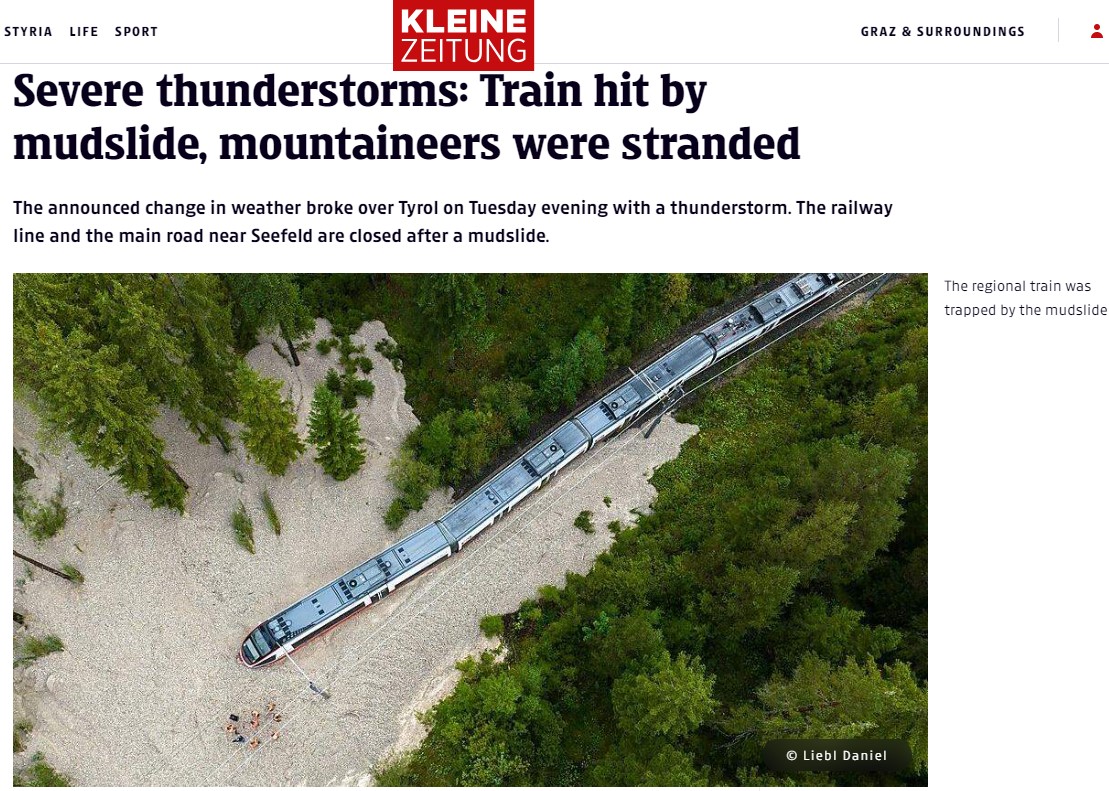Excess rainfall can pose a significant challenge to the smooth operation and safety of railways. Climate change makes these water related challenges more common, either through extreme weather events depositing much more rain than normal in storms, or climate change where rainfall is increased over longer periods. Let's explore how rain disrupts the railway rhythm and find some ways we can try to cope with the climate challenge.
Flooding
Probably the most obvious rain related issue is flooding of railway assets. Too much rain, too fast, can overwhelm drainage designs, inundating infrastructure.
The rules regarding when rail operations must stop vary around the world, but generally if you cannot see the top of the rail surface then operations are often regarded as unsafe, leaving passengers stranded (sometimes literally). In some cases, flooding poses a real risk to passenger life, particularly in confined spaces such as tunnels. Sadly, recent extreme rain claimed the lives of 12 rail passengers in China when rising floodwaters required the rescue of over 500 passengers
Flood waters are also typically not clean/fresh water, they typically come laden with contamination, whether that be mud, silt and soil washed from the landscape which can leave track ballast contaminated and track support and drainage compromised, to sewage from overflowing drains being a biohazard. In addition to contamination from flood water, water ingress can cause both rolling stock and infrastructure damage. Points motors and signal cabinets generally do not work well when submerged in water, and if third rail electrification is used then the hazards increase still further. Here we see a boiling electrified mud bath heated by the third rail electrification.
A balance must be struck between drainage design and the weather events that it is designed to cope with. The challenge is perhaps what weather we need to expect in the coming years. What used to be a 1 in 50 or 1 in 100-year event may now be seen much more regularly.
Scour
Fast flowing water poses new risks and challenges. A small stream can quickly turn into a raging river fuelled by heavy rainfall. Scour is the removal of material from the bed and banks of a river, stream, or other water channel. Material removal from around structure foundations can lead to structural damage or failure. Scour is the leading cause of bridge failures in the last 100 years in the UK, (where your author is based).
This rail bridge suffered significant structural failures due to scour from a river swollen by heavy rains in 2016.
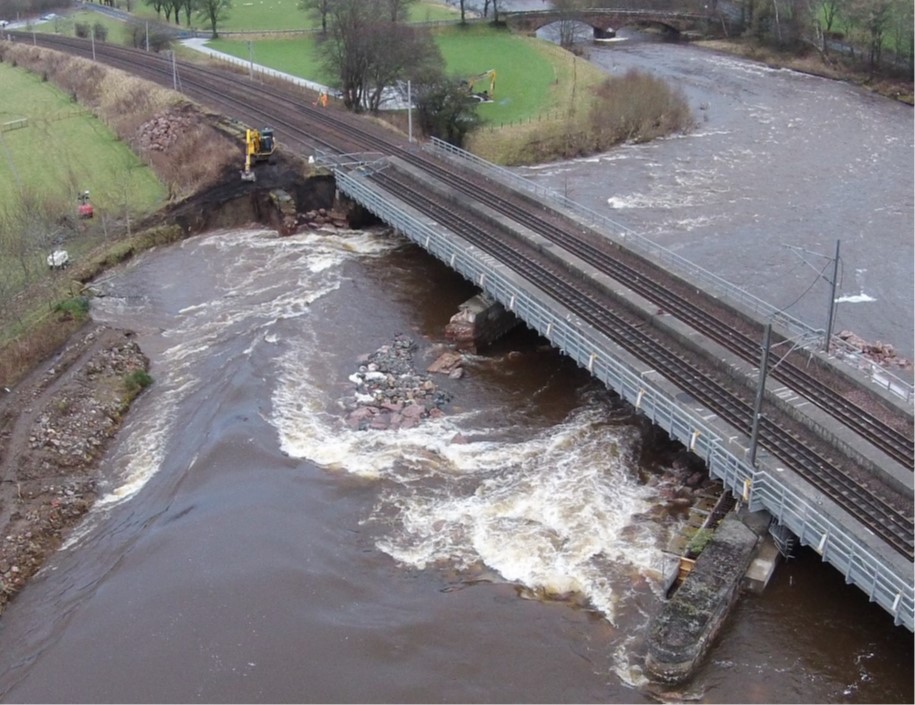
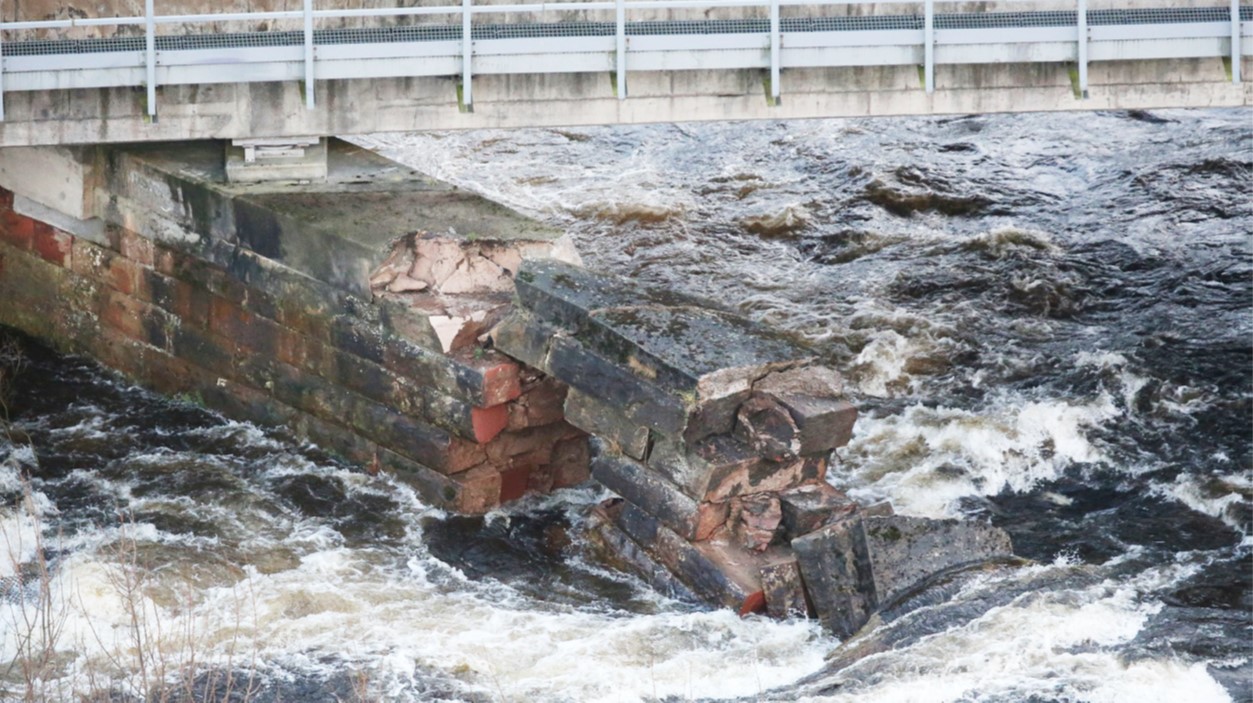
Images are Crown Copyright from the RAIB Report 22/2016 – Full investigation report here
Washout
We have seen that flowing water can move, and remove, material supporting the railway. A washout can be related to scour with fast flowing water moving ballast or other materials away from, or onto the track. However, a washout may also be caused by the sheer weight/pressure of water acting upon a structure such as an earth embankment. Where culverts are blocked, or collapsed, water can build up and exert huge destructive forces washing entire embankments away in seconds. Water is deceptively heavy. It weighs 1kg per litre, (or over 8 pounds per gallon for my North American readers) so forces on structures and earthworks soon build up as water levels rise. The quality of the following video isn’t great, but it is rare to see a rail washout in action, so I hope you’ll forgive the lack of pixels!
Washouts don't just affect the track formation, sometimes it is material washed out from above the track that can put rail operations at risk too.
This deadly example below comes from the UK, where material from a railway drain washed onto the track derailing a passenger train. 3 people died as a result of the derailment and every other person on the train was injured.
Video from RAIB (Railway Accident Investigation Branch) Synopsis report here
It isn't just passengers and freight that are affected too, increasingly penalties are paid by infrastructure owners or maintainers for incidents that happen, as a result of extreme weather. The accident in the video above from the UK (Carmont), resulted in a £6.7m fine for the infrastructure owner, Network Rail. In Turkey 9 rail officials were recently jailed for more than 108 years for a fatal extreme weather accident at Corlu.
Landslide / Landslip / Mudslide
Like washouts of the track, excess rain can cause the ground to become saturated with water altering the strength of the ground itself. This can lead to landslides, mudslides, and landslips where slopes become unstable, and material moves or cascades downward. Failures can be slow or sudden and vary in size from the small to the huge. Material can land on the tracks blocking them, track alignment can be affected, or the track support can disappear entirely all posing a high risk of rail accident.
Both these landslides examples below are local your author. The small landslide example on the left happened this week (May 2024), stopping all passenger and freight rail traffic along my local route. Buses introduced a 45 minutes delay to passengers wanting to complete their journey whilst repairs are carried out and I believe freight traffic was halted entirely while they moved 300 tonnes of spoil and placed new materials to reinforce the slope.
The second much larger and striking example on the right closed a busy passenger and freight route for over 5 months! It took the movement of 1,000,000 cubic metres (35,000,000 cu ft) of material to reinstate the track in 2013. The British geological survey have a case study on it here for those that want more detail. The failure was caused by failure of a spoil heap adjacent to the track. The rotational failure caused the tracks to lift and move and the spoil heap had to be removed to stabilise the track.
Images from Network Rail
Not all material flows are so solid, and mudslides can pose significant risks too as they often travel at significant speeds. Here is an example from Austria in September 2023, where a mudslide enveloped a train trapping it, thankfully with no injuries this time. News article here (in German).
What can we do?
Prediction
We could invest vast sums of money making our railway infrastructure more robust, improving drainage capacities, reinforcing slopes, making slopes less steep, and upgrading infrastructure equipment for under water use. However, in the real world we are constrained by capital, time, resource and often asset access too. Upgrading infrastructure whilst it is in operation is hard, expensive and takes time. Many railways are looking at how they can better manage weather risks through improved predictions of both local weather and how their asset responds developing improved models to identify and prioritise investment plans as well as cope with extreme weather events from an operational perspective.
Infrastructure Monitoring
There are many infrastructure monitoring solutions, from water level sensors highlighting blockages and rising water levels in drainage, through to remote weather stations giving improved resolution of weather measurement, and many, many more to monitor specific properties of asset performance.
Some of the highest-risk rain-related asset failures are landslides and track washouts due to the derailment risk for passengers and freight. These are also typically the hardest to predict due to the uncertainty of what lies beneath the ground or outside the railway boundaries and therefore often limiting the rail networks control.
Whilst there are sensors you can install where you have seen (or suspect) slope issues, these aren’t practical or cost efficient to install along long distances. The use of fiber optic Distributed Acoustic Sensing, however, can potentially detect issues along entire rail routes providing 24/7 alerts to landslides, rockfalls and other ground moving incidents. The technology monitors ground vibrations such as that caused during a landslide via a fiberoptic cable laid alongside the track. It can even be an unused fiber in existing signalling or telecoms bundles. You can find out more about the technology here, and its application for landslide detection here. One of its most attractive aspects is the speed of roll out as one sensor can monitor 100km of fiber, something which traditional sensors cannot offer.
Learning to live with rain related disruptions
Earlier I hinted at investment and improvement of railway infrastructure taking a significant time, (and cost!). However, the increasingly extreme weather challenges are here – Now.
To some degree, we must learn to live with these watery weather challenges, putting in place risk management and mitigation strategies in the short term, to keep people and freight safe today and tomorrow. But we must do this at the same time as planning and implementing more robust long-term solutions too.
There perhaps unsurprisingly is no magic fix, but instead much work across rail disciplines is needed to achieve a rain resilient railway. Increasing the intelligence of infrastructure is one aspect that informs both current and future streams of this vital resilience work, allowing rapid response to emerging issues, whilst gathering and prioritising the longer-term investments needed to keep this green transport mode relevant for the next generations of users.
Summing up
Climate change is expected to increase the frequency and intensity of extreme weather events, including heavy rainfall.
By adopting proactive risk management strategies driven by more intelligent infrastructure, we must learn to cope with challenges today, giving us time to invest in resilience improvements making our rail infrastructure fit for the future. Doing both is essential to ensure this vital transportation mode continues to operate safely and efficiently now and in the future.
A sustainable rail network plays a crucial role in reducing our carbon footprint which plays its part in reducing the trend of increasing extreme weather incidents. Building rain resilience ensures this green mode of transport remains a reliable and attractive choice for users.
It isn’t an easy journey ahead but let's work together to weather the storms and prepare our networks to keep running smoothly, come rain or shine.
This series of articles has touched on some of the challenges that climate change and increasingly extreme weather poses for the railway and some of the ways it can rise to these challenges. If you’ve missed any of them, you can find links here:
If you'd have an infrastructure monitoring challenge then get in touch to see where we can help
Like this article? Then share it with the button at the top.
